3
THE SEVEN PILLARS OF ACCOUNTABILITY
Corporation: An ingenious device for obtaining individual profit without individual responsibility.
—Ambrose Bierce
from The Devil’s Dictionary
For centuries, bridges have been built to connect two points of land separated by valleys and bodies of water.
The ancient Greeks are credited with constructing the world’s first arch bridge during the Bronze Age around 1300 B.C.E. near the modern road from Tiryns to Epidaurus, but it was Roman engineers who first fully realized and exploited the potential of arches for construction.1
Despite other types of bridges (beam, cable-stayed, cantilever, suspension, truss), the arch bridge is a metaphor for the four significant attributes to building and sustaining a culture where accountability is the essential factor in high-performing organizations:
1. Interdependence. Each piece of stone in an arch is vital. If just one stone from the arch fails, the entire arch fails and the bridge collapses. The arches create the span between pillars, giving the bridge its strength while the pillars anchor the arches, giving the bridge its stability. As we examine the Seven Pillars of Accountability, we’ll see again and again that all seven pillars must be in place for an organization to be considered a high-performing enterprise. Consistent performance across all seven pillars is where organizations struggle.
2. Endurance. The Romans built their bridges to last. Most were constructed more than 2,000 years ago, and except for those destroyed during war, virtually all of them are in use today. One of the most famous and beautiful Roman arch bridges is the Alcántara Bridge (also known as Puente Trajan at Alcántara) built over the Tagus River at Alcántara, Spain. This bridge was built between 104 and 106 C.E. by order of Roman Emperor Trajan, and bears the inscription PONTEM PERPETUI MANSURUM IN SAECULA (I HAVE BUILT A BRIDGE WHICH WILL LAST FOREVER).2 Like these Roman bridges, successful organizations endure.
3. Adaptive. The Romans didn’t invent the arch bridge, but they perfected it. The Etruscans were building arch bridges but struggled with creating a structure strong enough to span great distances while being able to bear heavy loads without collapsing under the bridge’s own weight. Roman engineers solved this problem by developing the voussoir keystone arch. This adaptation of an existing technology enabled the Romans to build highly effective aqueducts and bridges throughout their vast empire, including the Puente Romano over the Guadiana River at Mérida, Spain, which for 1,000 years was the longest arch bridge in the world. The principles, approaches, and tools in this book work for any organization, transcending age, geography, industry, and size. Enduring organizations aren’t afraid to adapt.
4. Responsibility. According to legend, Roman engineers in charge of designing and directing bridge construction were expected to stand directly beneath the center of the arch as the capstone was placed in position. Smart design, flawless execution, and trust were no longer abstract ideas. The ultimate test of responsibility occurred when the final stone holding the entire arch in place was inserted and the engineer’s life literally was at stake. Accountability in the workplace is most noticeable at the end of projects, but we will learn—as the ancient Romans learned—that failure to pay attention to accountability along the way can be deadly. Are you and your colleagues willing to stand under the weight of your decisions?
Because accountability is a collection of beliefs and steps applied on a consistent basis, I would like you to invest a few minutes to take this assessment. The assessment is based on the principles, beliefs, and activities of some of the world’s most admired companies and is designed to help you get a sense of your own organization’s effectiveness.
Let’s face it: You can’t improve if you don’t know what’s working and what’s not.
Respond to each of the following statements by choosing a number:
5 our organization consistently conforms to this statement
4 our organization usually conforms
3 our organization conforms or doesn’t conform about equally
2 our organization occasionally conforms
1 our organization rarely or never conforms
This assessment is for your benefit. If you are not brutally honest with yourself, your score will be meaningless and fail to indicate opportunities for improvement. Respond to each statement as things are now, rather than as you wish they were.
You will tally your scores at the end of this chapter.
SECTION A—CHARACTER

SECTION B—UNITY
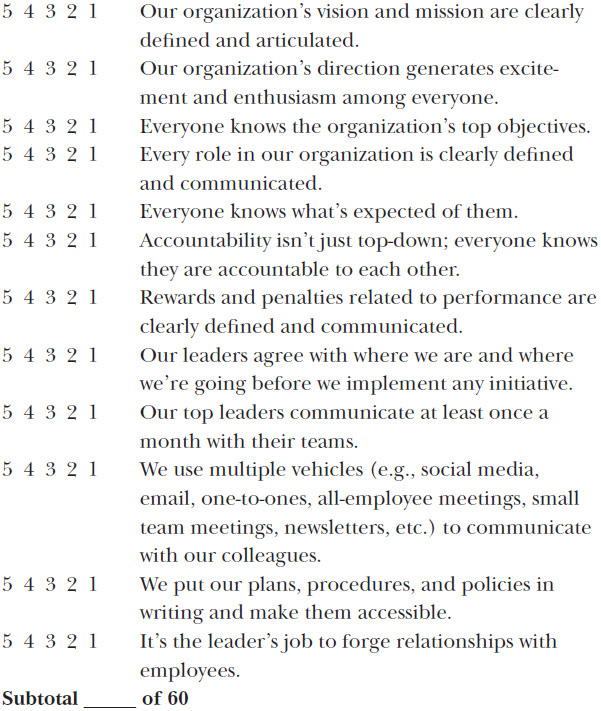
SECTION C—LEARNING
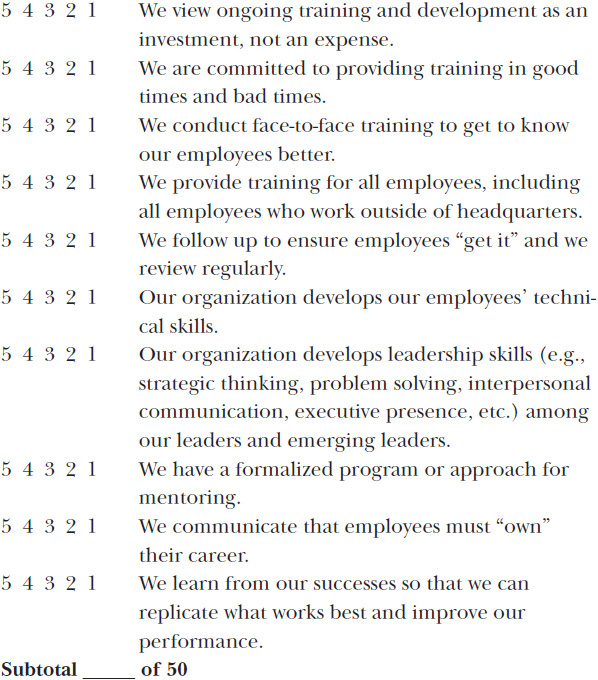
SECTION D—TRACKING
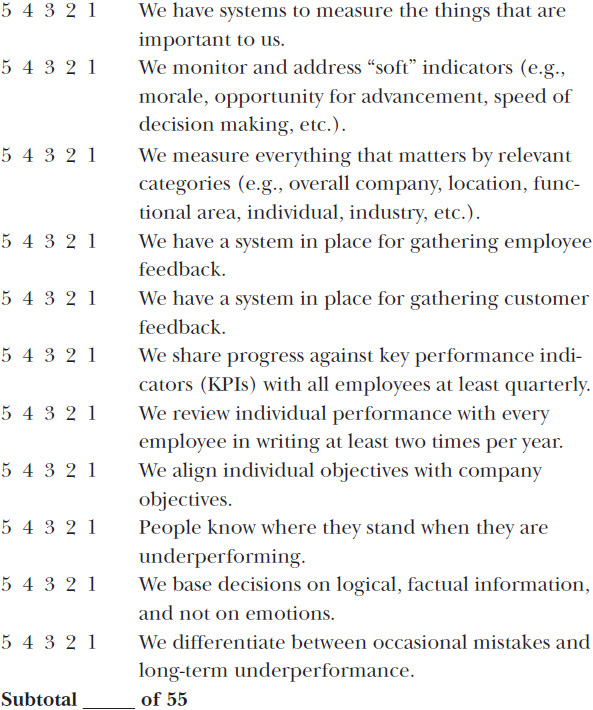
SECTION E—URGENCY
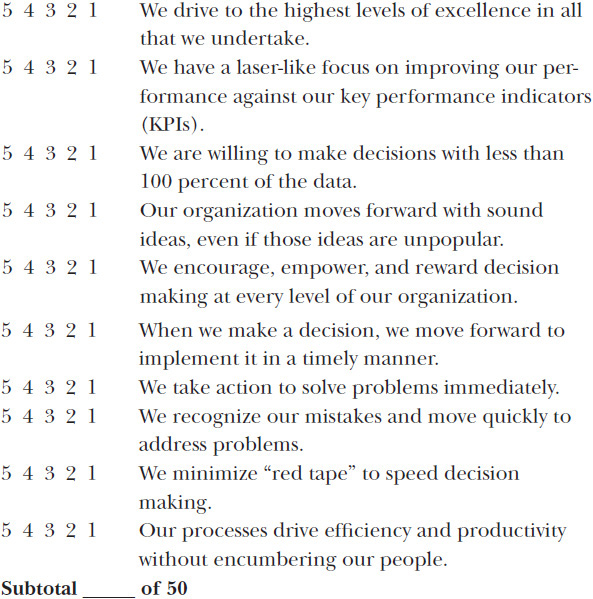
SECTION F—REPUTATION

SECTION G—EVOLVING

This assessment will benchmark you and your organization against some of the most exceptional companies in the world.
COMPARE YOUR SCORE
To receive even greater benefit from this assessment, ask your direct reports to take the assessment.
When you provide the assessment to your colleagues it would be ideal if you eliminate the headings on the assessment and rearrange randomly the prompts to ensure a more truthful response.
Over a 21-month period, 82 leadership teams in the United States and Canada completed the accountability assessment. In all but two cases, the overall score of the 82 CEOs taking the assessment was higher than the scores of the 489 other executives (shown in the graph). The CEOs’ scores for each of the Seven Pillars also were higher in all but two cases than those of their direct reports. Although no additional analysis was conducted to explain the gap, the fact that 98 percent of these CEOs viewed their organization’s performance against key accountability drivers as markedly better than their direct reports is a gap that likely will occur when you and your leaders complete the assessment.
Your position in the organization will give you a biased view of performance. Leaders usually are more optimistic than their colleagues.
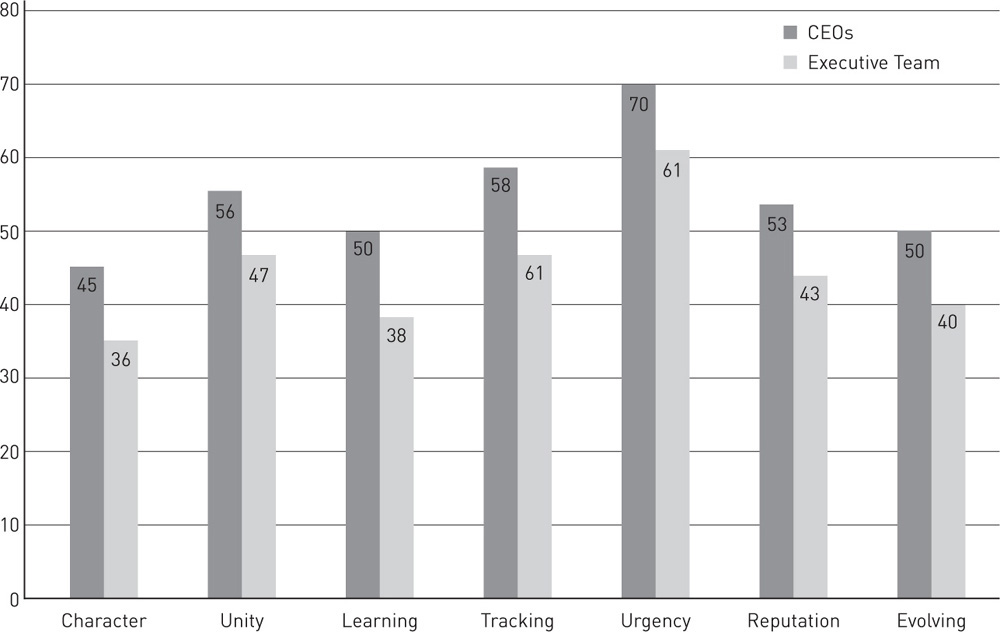
Figure 3.1 CEO vs. Executive Team
When all of your leaders have completed the assessment, ask them to bring their individual assessments to a meeting to discuss their results. The scores will tell you one thing, but it’s the conversation your team has about the assessment that has the potential to make the most impact on your organization’s performance. Discuss as a team the learning that occurred from the assessment. Seek to understand differences of opinion about how and why people responded to certain statements the way they did. Pinpoint areas with opportunity for improvement and agree to take action.
If approached with candor and the willingness to understand points of view that differ from your own, this conversation can be a game-changer. The trust you build and the action you agree to take are essential steps toward becoming an exceptional organization.
WHAT THE SCORES MEAN
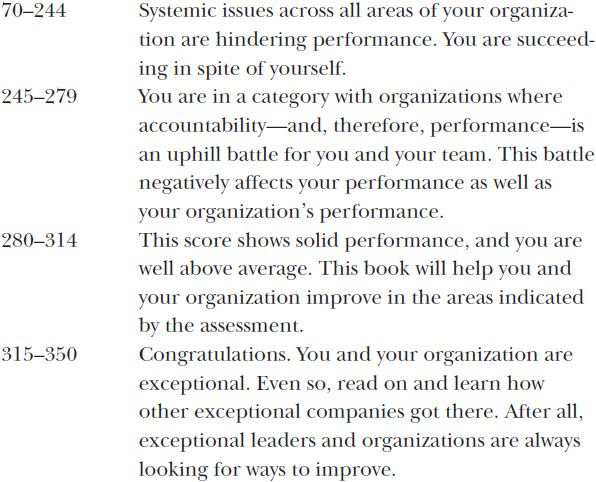
Beginning with the next chapter, we examine in detail how exceptional companies nurture and sustain a culture of purpose, accountability, and fulfillment by building a bridge to help them get from Point A to Point B. This bridge is supported by the Seven Pillars of Accountability.
